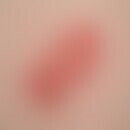Synonym(s)
HistoryThis section has been translated automatically.
DefinitionThis section has been translated automatically.
Chronic superficial infection of the skin, mainly in children, less frequently in adults, confined to the perianal region, induced by streptococci (preferably group A streptococci) and presenting with the appearance of a weeping intertriginous dermatitis.
You might also be interested in
PathogenThis section has been translated automatically.
Mostly beta-hemolytic group A streptococci (GABHS: 70%);
Less frequently group B streptococci (GBBHS: 26%), C, D or G (Šterbenc A et al. 2016).
EtiopathogenesisThis section has been translated automatically.
Skin infection (oral-fecal transmission?) with streptococci.
- Promoting factors:
- Trauma
- injuries of the skin
- shared bath water.
ManifestationThis section has been translated automatically.
Infants aged between 1 and 10 years.
ClinicThis section has been translated automatically.
Rarely any fever. Usually non-infiltrated or only slightly infiltrated, easily delimited perianal erythema of 0.5-3.0 cm Ø or red, weeping papules which occasionally secrete pus. Severe, persistent itching and defecation pain. Bloody stool deposits in 30-40% of cases.
There is often association with impetigo in other parts of the body.
Rare picture of balanitis or vulvovaginitis.
DiagnosisThis section has been translated automatically.
Clinic, smear and bacteria culture. The diagnosis is often missed; in children, for example, it takes an average of 1-12 months until the diagnosis is made.
Smears from the throat and nasal atria are very useful.
Differential diagnosisThis section has been translated automatically.
Remark: When considering the differential diagnosis it should always be kept in mind that 1. perianal streptococcal dermatitis is rare and 2. that it occurs predominantly in young children. This limits a part of the differential diagnosis listed here.
- Atopic anal eczema: diffuse intertriginous eczema reaction; other signs of atopic dermatitis.
- Psoriasis inversa: usually sharply defined intertriginous red plaques, weepingContact allergic anal eczema:; usually in adults; other signs of psoriasis.
- Tinea intertriginosa: circinate marginal plaques, central tendency to heal.
- Intertriginous candidiasis: circular weeping plaques, marginal scaling
- M. Bowen: slowly growing red plaque, usually no significant symptoms (older age).
- Extramammary Paget 's disease: slow-growing red plaque, usually no significant symptoms (older age).
- Cumulative toxic anal eczema : diffuse intertriginous eczema reaction; history with sepcific local therapy.
External therapyThis section has been translated automatically.
Internal therapyThis section has been translated automatically.
Therapy of choice is penicillin (e.g. Megacillin oral). Adults and children > 12 LJ: 3 times/day 0.5 million to 1.5 million IU p.o. Therapy duration 10-14 days. Children 6-12 LJ: 3 times/day 0.6 million IU p.o. for 10-14 days. Children < 6 LJ: 3 times/day 0.3 million IU p.o.
Alternative: treatment with erythromycin 3 times/day 500 mg p.o. for two weeks.
Alternative: Cephalosporins like cefuroxime or ceftriaxone for 12-14 days.
Note: Some studies indicate that the recurrence rate is higher when oral penicillins and aminopenicillins are used than when 2nd or 3rd generation cephalosporins are used.
Progression/forecastThis section has been translated automatically.
The clinical picture is characterized by a high (between 20 and 40%) recurrence rate within 6 weeks after completion of treatment. This is higher when oral penicillins are used than when cephalosporins are used (see above).
If the consequent antibiotic/antiseptic therapy does not lead to healing, the following procedure is recommended: Intermittent (1-3 days each) anti-inflammatory therapy with a steroid externum (class 1-2 according to Niedner) or a local calcineurin inhibitor.
LiteratureThis section has been translated automatically.
- Amren DP et al (1966) Perianal cellulitis associated with group A streptococci. Am J Dis Child 112: 546-552
- Heidelberger A et al (2000) Perianal streptococcal dermatitis. dermatologist 51: 86-89
- Herbst R et al (2003) Perineal streptococcal dermatitis/disease: recognition and management. At J Clin Dermatol 4: 555-560
- Kahlke V et al (2013) Perianal streptococcal dermatitis in adults: its association with pruritic anorectal diseases is mainly caused by group B streptococci. Colorectal Dis 15:602-607
- Lazarov A (1999) Perianal contact dermatitis caused by nail lacquer allergy. At J Contact Dermat 10: 43-44
- Lunghi F et al (2001) Two familial cases of perianal streptococcal dermatitis. Cutis 68: 183-184
- Mempel M et al (2015) Selected bacterial infections of the skin in childhood. dermatologist 66: 252-257
- Meury SN et al (2008) Randomized, comparative efficacytrial of oral penicillin versus cefuroxime for perianal streptococcal dermatitis in children. J Pediatr 153:799-802
- Neri I et al (1996) Perianal streptococcal dermatitis in adults. Br J Dermatol 135: 796-798
- Olson D et al (2011) Outcomes in children treated for perineal group A beta-hemolytic streptococcal dermatitis. Pediatric Infect Dis J 30:933-996
- Peltola H (2000) Images in clinical medicine. Bacterial perianal dermatitis. N Engl J Med 342: 1877
Šterbenc A et al (2016) Microbiological characteristics of perianal streptococcal dermatitis:
aretrospective study of 105 patients in a 10-year period. Acta Dermatovenerol Alp Pannonica Adriat 25:73-76.
Incoming links (6)
Anal dermatitis cumulative toxic; Anal eczema contact allergic; Anal fissure; Diaper dermatitis; Perianal streptococcal dermatitis; Streptococcus;Outgoing links (15)
Anal dermatitis cumulative toxic; Balanitis; Bowen's disease; Calcineurin inhibitors; Candidoses; Clioquinol; Erythromycin; Glucorticosteroids topical; Inverted psoriasis; Octenidine; ... Show allDisclaimer
Please ask your physician for a reliable diagnosis. This website is only meant as a reference.





